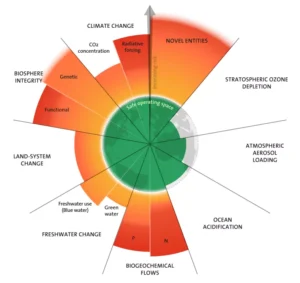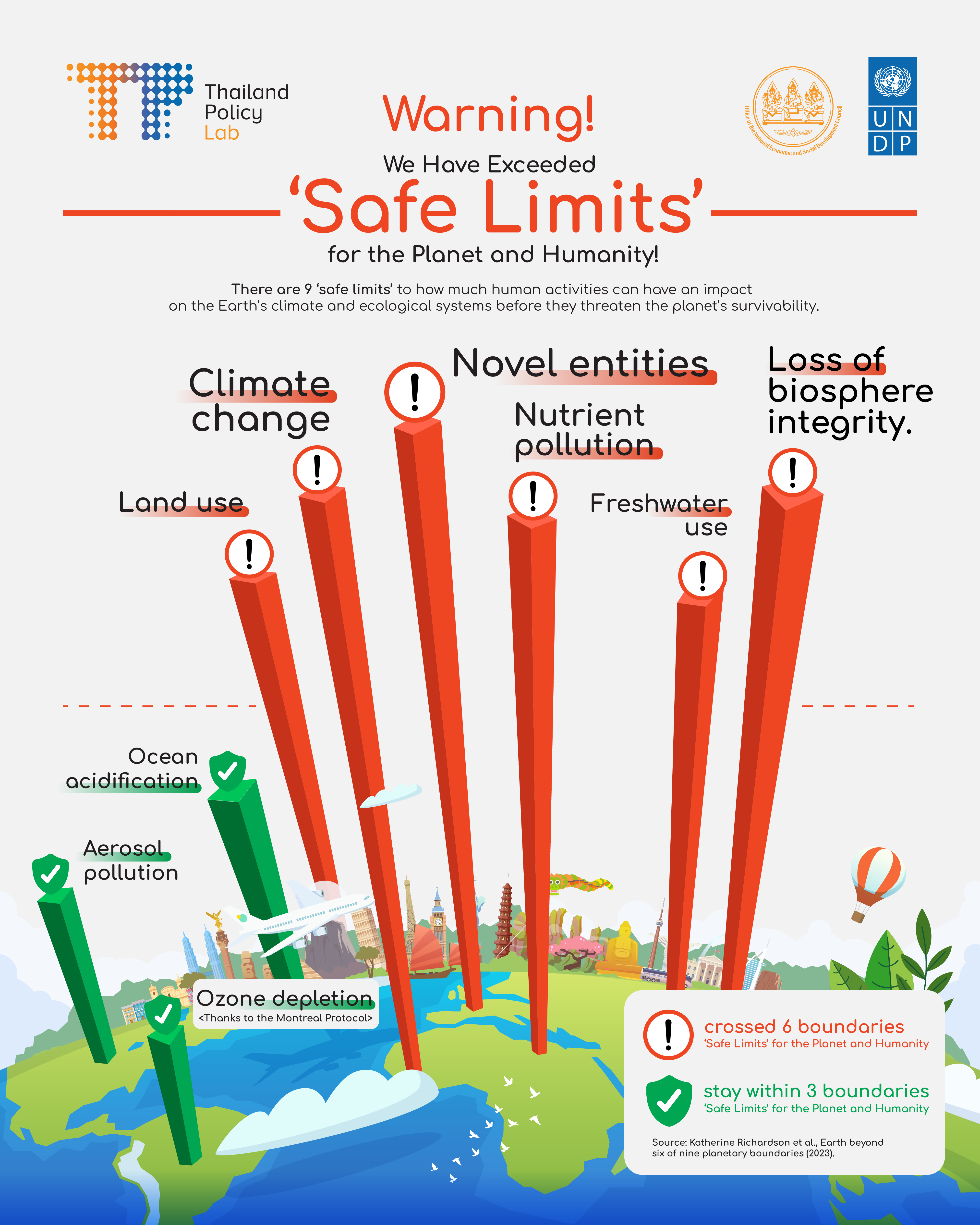Good news! For the first time scientists have successfully identified 9 planetary boundaries — an environmental conceptual framework that sets ‘safe limits’ to how much human activities can have an impact on the Earth’s climate and ecological systems before they threaten the planet’s survivability. These 9 boundaries are drawn for…
- Loss of biosphere integrity — this includes genetic diversity, extinction rate, and the intensity of primary production.
- Freshwater use, soil moisture, and the availability of blue water (surface water and groundwater for home use) and green water (water for plant use).
- Land use and forest loss rate.
- Nutrient pollution (from nitrogen and phosphorus in synthetic fertilisers).
- Atmospheric CO2 level and radiative forcing — the primary indicators of climate change.
- The amount of novel entities (human-synthesised substances) released into the environment.
- Ozone depletion.
- Aerosol pollution.
- Ocean acidification.

The visualisation of the the planetary boundaries framework
The bad news is…we have breached 6 out of 9 boundaries. The level of CO2 concentrated in the atmosphere and radiant energy on Earth’s surface has long surpassed the boundary limits. The current rate of human-made extinction is 100 times higher than the average rate. The ecosystems are suffering from algae blooms and oceanic dead zones caused by biogeochemical waste. Soil moisture that keeps the entire Amazon rainforest alive is disappearing. Only 60% of tropical and boreal forests are retained when it should be at least 75%. And as we breathe, nanoparticles from toxic chemicals are being absorbed into our brains.
Although this bleak development might not usher in a sudden apocalypse, it means that we have already ventured into multiple dangerous territories, and are at least one step closer to the collapse of the ecological system.
But even a dry cloud caused by air pollution has a silver lining. At least ozone depletion, aerosol pollution, and ocean acidification remain in the ‘green zone.’ Although the acidity level of the oceans and aerosol pollution are on the rise, the ozone layer has shown signs of recovery, and scientists estimate that the ozone holes should start closing up as soon as 2045. It is not by miracle that the world is heading towards this direction. Policy decisions are what get us to this point, and the will to change can translate into public policy that leads us out of the red zone.
Meet the Montreal Protocol — the hallmark of international cooperation on global policy of biosphere protection
The reason that we have a steadfast progress of ozone recovery is the Montreal Protocol on Substances That Deplete the Ozone Layer. Coming into force in 1989, this treaty represents the international community’s unanimous agreement to ban nearly 100 ozone-depleting chemicals, notably chlorofluorocarbons (CFCs). A total of 197 U.N. member states are signatories to this treaty. More than 99% of the blacklisted chemicals have since completely phased out.
The Montreal Protocol began when scientists in the 1970s discovered that industrial chemicals hollowed out the ozone layer. Without this atmospheric protection, Earth would be directly hit with ultraviolet radiation — the major cause of skin cancer and cataract. It was estimated that, in the U.S. alone, a number of skin cancer cases would skyrocket to 280 million cases, with at least 1.5 million skin cancer deaths. The world’s temperature would also increase by 25%, resulting in the degradation of the climate system that rendered the world inhabitable for all living beings.
Despite harms of ozone depletion, the legislation for banning highly toxic substances was not a bed of roses. The chemicals industry attempted to lobby against government intervention on CFCs, citing the ‘groundlessness’ of the scientists’ claims of ozone depletion, dangerous substances, and health-environmental concerns as well as the negative impact on the economy due to the elimination of various chemicals.
Amidst a sustained assault from corporates, the Montreal Protocol was ratified by every country in the world. Even conservative politicians recognised values in climate policy. The Reagan government, for example, considered the treaty to be an ‘insurance policy’ that could safeguard the world in case all the predictions came true. Not only the Montreal Protocol successfully phased out almost every ozone-depleting chemical within 7 years, it also brought the chemicals industry and scientists to create technological replacements for banned chemicals, opening up an entirely new market of more environmentally friendly products and pushing all parties to innovate in the pursuit of sustainability.
Here are lesson extracted from the success of the Montreal Protocol:
- We can still take a step back from a no-go zone if there is a solid and genuine political will to do so. The treaty has proved that its radical cause did not throw the chemicals economy into a state of chaos. Instead, it broadened our socio-economic and political imaginations about what should and could be done.
- Environmental issues are everyone’s issue. Climate change and the integrity of the biosphere cut across the political spectrum. The Montreal Protocol was spearheaded by even the staunchest conservatives such as Margaret Thatcher and Ronald Raegan, who also took part in transitioning the chemicals industry out of its dependence on CFCs.
- Environmental issues will always intertwine with other issues. What holds centrality in the atmospheric scientists’ claims of ozone depletion is how environmental conditions shape the ways we live. A delay in ozone recovery can unleash an unprecedented public health catastrophe.
- We should revisit our understanding of value that centres economic prosperity. The Montreal Protocol is an assertion that lives are precious and economic advancement should not be accompanied by mass premature death. To take part in a living world is to think above and beyond economic metrics.
Sources:
CBC https://shorturl.at/inDK0
Greenpeace Position Paper https://shorturl.at/aktHP
National Geographic https://shorturl.at/bgkE7
Science https://shorturl.at/aknD6
Scientific American https://shorturl.at/qKZ28
Stockholm Resilience Center https://rb.gy/wl3bh3

